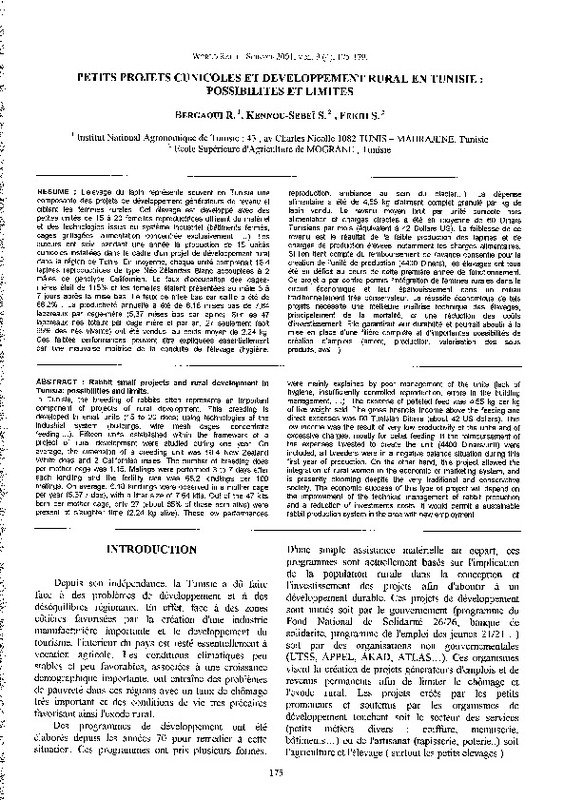JavaScript is disabled for your browser. Some features of this site may not work without it.
Buscar en RiuNet
Listar
Mi cuenta
Estadísticas
Ayuda RiuNet
Admin. UPV
PETITS PROJETS CUNICOLES ET DEVELOPPEMENT RURAL EN TUNISIE :POSSIBILITES ET LIMITES
Mostrar el registro sencillo del ítem
Ficheros en el ítem
| dc.contributor.author | Bergaoui, R.
|
|
| dc.contributor.author | Kennou- Sebeï, S.
|
|
| dc.contributor.author | Fekih, S.
|
|
| dc.date.accessioned | 2011-02-24T14:21:58Z | |
| dc.date.available | 2011-02-24T14:21:58Z | |
| dc.date.issued | 2001 | |
| dc.identifier.issn | 1257-5011 | |
| dc.identifier.uri | http://hdl.handle.net/10251/10019 | |
| dc.description.abstract | [EN] In Tunisia, the breeding of rabbits often represents an importan! componen! of projects of rural development. This breeding is developed in small units (15 to 20 does) using technologies of the industrial system (buildings, wire mesh cages, concentrate feeding .... ). Fifteen units established within the framework of a project of rural development were studied during one year. On average, the dimension of a breeding unit was 18.4 New Zealand White does and 2 Californian males. The number of breeding does per mother cage was 1 .15. Matings were performed 3 to 7 days after each kindling and the fertility rate was 66.2 kindlings per 100 matings. On average, 6.18 kindlings were observed in a mother cage per year (5.37 I doe), with a litter size of 7.64 kits. Out of the 47 kits born per mother cage, only 27 (about 65% of !hose born alive) were present at slaughter time (2.24 kg alive). These low performances were mainly explained by peor management of the units (lack of hygiene, insufficiently controlled reproduction, errors in the building management, ... ). The expense of pelleted feed was 4.55 kg per kg of live weight sold. The gross financia! income above the feeding and direct expenses was 60 Tunisian Dinars (about 42 US dollars). This low income was the result of very low productivity of the units and of excessive charges, mostly for pelle! feeding. lf the reimbursement of the expenses invested to create the unit (4400 Dinars/unit) were included, ali breeders were in a negative balance situation during this first year of production. On the other hand, this project allowed the integration of rural women in the economic or marketing system, and is presently blooming despite the very traditional and conservative society. The economic success of this type of project will depend on the improvement of the technical management of rabbit production and a reduction of investments costs. lt would permit a sustainable rabbit production system in the area with new employment | es_ES |
| dc.description.abstract | [FR] L'élevage du lapin représente souvent en Tunisie une composante des projets de développement générateurs de revenu et ciblant les femmes rurales. Cet élevage est développé avec des petites unités de 15 a 20 femelles reproductrices utilisant du matériel et des technologies issus du systeme industrie! (batiments fermés, cages grillagées, alimentation concentrée exclusivement, ... ). Les auteurs ont suivi pendan! une année la production de 15 unités cunicoles installées dans le cadre d'un projet de développement rural dans la région de Tunis. En moyenne, chaque unité comprenait 18,4 lapines reproductrices de type Néo-Zélandais Blanc accouplées a 2 males de génotype Californien. Le taux d'occupation des cagesmeres était de 115% et les femelles étaient présentées au male 3 a 7 jours apres la mise bas. Le taux de mise bas par saillie a été de 66,2% . La productivité annuelle a été de 6,18 mises bas de 7,64 lapereaux par cage-mere (5,37 mises bas par lapine). Sur les 47 lapereaux nés totaux par cage mere et par an, 27 seulement (soit 65% des nés vivants) ont été vendus, au poids mayen de 2,24 kg. Ces faibles performances peuvent etre expliquées essentiellement par une mauvaise maitrise de la conduite de l'élevage (hygiene reproduction, ambiance au sein du clapier ... ). La dépense alimentaire a été de 4,55 kg d'aliment complet granulé par kg de lapin vendu. Le revenu mayen brut par unité cunicole hors alimentation et charges directes a été en moyenne de 60 Dinars Tunisiens par mois (équivalent a 42 Dollars US). La faiblesse de ce revenu est le résultat de la faible production des lapines et de charges de production élevées, notamment les charges alimentaires. Si l'on tient compte du remboursement de !'avance consentie pour la création de l'unité de production (4400 Dinars), les élevages ont tous été en déficit au cours de cette premiere année de fonctionnement. Ce projet a par centre permis l'intégration de femmes rurales dans le circuit économique et leur épanouissement dans un milieu traditionnellement tres conservateur. La réussite économique de tels projets nécessite une meilleure maitrise technique des élevages, principalement de la mortalité, et une réduction des coOts d'investissement. Elle garantirait leur durabilité et pourrait aboutir a la mise en place d'une filiere complete et d'importantes possibilités de création d'emplois (amont, production, valorisation des sous produits, aval ... ). | |
| dc.language | Inglés | es_ES |
| dc.publisher | World Rabbit Science. ICTA. UPV | es_ES |
| dc.relation.ispartof | World Rabbit Science | |
| dc.rights | Reserva de todos los derechos | es_ES |
| dc.title | PETITS PROJETS CUNICOLES ET DEVELOPPEMENT RURAL EN TUNISIE :POSSIBILITES ET LIMITES | es_ES |
| dc.type | Artículo | es_ES |
| dc.date.updated | 2011-02-24T14:11:44Z | |
| dc.identifier.doi | 10.4995/wrs.2001.463 | |
| dc.rights.accessRights | Abierto | es_ES |
| dc.description.bibliographicCitation | Bergaoui, R.; Kennou- Sebeï, S.; Fekih, S. (2001). PETITS PROJETS CUNICOLES ET DEVELOPPEMENT RURAL EN TUNISIE :POSSIBILITES ET LIMITES. World Rabbit Science. 9(4). https://doi.org/10.4995/wrs.2001.463 | es_ES |
| dc.description.accrualMethod | SWORD | es_ES |
| dc.relation.publisherversion | https://doi.org/10.4995/wrs.2001.463 | |
| dc.description.volume | 9 | |
| dc.description.issue | 4 | |
| dc.identifier.eissn | 1989-8886 | es_ES |








